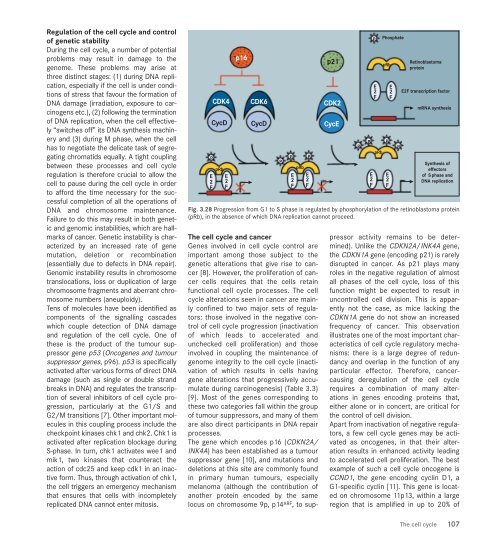world cancer report - iarc
world cancer report - iarc
world cancer report - iarc
Create successful ePaper yourself
Turn your PDF publications into a flip-book with our unique Google optimized e-Paper software.
Regulation of the cell cycle and control<br />
of genetic stability<br />
During the cell cycle, a number of potential<br />
problems may result in damage to the<br />
genome. These problems may arise at<br />
three distinct stages: (1) during DNA replication,<br />
especially if the cell is under conditions<br />
of stress that favour the formation of<br />
DNA damage (irradiation, exposure to carcinogens<br />
etc.), (2) following the termination<br />
of DNA replication, when the cell effectively<br />
“switches off” its DNA synthesis machinery<br />
and (3) during M phase, when the cell<br />
has to negotiate the delicate task of segregating<br />
chromatids equally. A tight coupling<br />
between these processes and cell cycle<br />
regulation is therefore crucial to allow the<br />
cell to pause during the cell cycle in order<br />
to afford the time necessary for the successful<br />
completion of all the operations of<br />
DNA and chromosome maintenance.<br />
Failure to do this may result in both genetic<br />
and genomic instabilities, which are hallmarks<br />
of <strong>cancer</strong>. Genetic instability is characterized<br />
by an increased rate of gene<br />
mutation, deletion or recombination<br />
(essentially due to defects in DNA repair).<br />
Genomic instability results in chromosome<br />
translocations, loss or duplication of large<br />
chromosome fragments and aberrant chromosome<br />
numbers (aneuploidy).<br />
Tens of molecules have been identified as<br />
components of the signalling cascades<br />
which couple detection of DNA damage<br />
and regulation of the cell cycle. One of<br />
these is the product of the tumour suppressor<br />
gene p53 (Oncogenes and tumour<br />
suppressor genes, p96). p53 is specifically<br />
activated after various forms of direct DNA<br />
damage (such as single or double strand<br />
breaks in DNA) and regulates the transcription<br />
of several inhibitors of cell cycle progression,<br />
particularly at the G1/S and<br />
G2/M transitions [7]. Other important molecules<br />
in this coupling process include the<br />
checkpoint kinases chk1 and chk2. Chk1 is<br />
activated after replication blockage during<br />
S-phase. In turn, chk1 activates wee1 and<br />
mik1, two kinases that counteract the<br />
action of cdc25 and keep cdk1 in an inactive<br />
form. Thus, through activation of chk1,<br />
the cell triggers an emergency mechanism<br />
that ensures that cells with incompletely<br />
replicated DNA cannot enter mitosis.<br />
Fig. 3.28 Progression from G1 to S phase is regulated by phosphorylation of the retinoblastoma protein<br />
(pRb), in the absence of which DNA replication cannot proceed.<br />
The cell cycle and <strong>cancer</strong><br />
Genes involved in cell cycle control are<br />
important among those subject to the<br />
genetic alterations that give rise to <strong>cancer</strong><br />
[8]. However, the proliferation of <strong>cancer</strong><br />
cells requires that the cells retain<br />
functional cell cycle processes. The cell<br />
cycle alterations seen in <strong>cancer</strong> are mainly<br />
confined to two major sets of regulators:<br />
those involved in the negative control<br />
of cell cycle progression (inactivation<br />
of which leads to accelerated and<br />
unchecked cell proliferation) and those<br />
involved in coupling the maintenance of<br />
genome integrity to the cell cycle (inactivation<br />
of which results in cells having<br />
gene alterations that progressively accumulate<br />
during carcinogenesis) (Table 3.3)<br />
[9]. Most of the genes corresponding to<br />
these two categories fall within the group<br />
of tumour suppressors, and many of them<br />
are also direct participants in DNA repair<br />
processes.<br />
The gene which encodes p16 (CDKN2A/<br />
INK4A) has been established as a tumour<br />
suppressor gene [10], and mutations and<br />
deletions at this site are commonly found<br />
in primary human tumours, especially<br />
melanoma (although the contribution of<br />
another protein encoded by the same<br />
locus on chromosome 9p, p14 ARF, to sup-<br />
pressor activity remains to be determined).<br />
Unlike the CDKN2A/INK4A gene,<br />
the CDKN1A gene (encoding p21) is rarely<br />
disrupted in <strong>cancer</strong>. As p21 plays many<br />
roles in the negative regulation of almost<br />
all phases of the cell cycle, loss of this<br />
function might be expected to result in<br />
uncontrolled cell division. This is apparently<br />
not the case, as mice lacking the<br />
CDKN1A gene do not show an increased<br />
frequency of <strong>cancer</strong>. This observation<br />
illustrates one of the most important characteristics<br />
of cell cycle regulatory mechanisms:<br />
there is a large degree of redundancy<br />
and overlap in the function of any<br />
particular effector. Therefore, <strong>cancer</strong>causing<br />
deregulation of the cell cycle<br />
requires a combination of many alterations<br />
in genes encoding proteins that,<br />
either alone or in concert, are critical for<br />
the control of cell division.<br />
Apart from inactivation of negative regulators,<br />
a few cell cycle genes may be activated<br />
as oncogenes, in that their alteration<br />
results in enhanced activity leading<br />
to accelerated cell proliferation. The best<br />
example of such a cell cycle oncogene is<br />
CCND1, the gene encoding cyclin D1, a<br />
G1-specific cyclin [11]. This gene is located<br />
on chromosome 11p13, within a large<br />
region that is amplified in up to 20% of<br />
The cell cycle 107

















